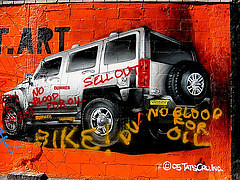
COMPUTERWORLD
Originally uploaded by pylbug.
Yesterday, while suffering through my umpteenth coolhunting / trendwatching presentation, it hit me: the ultimate trend right now is trendwatching, but the trendwatchers don't realize it. The shift from "mass media" to "media of the masses" is a real problem for most marketers and merchants-of-cool. But it's not just the learning curve involved with new technology, nor is it because "cool" is so elusive. It's a fundamental ignorance as to how culture evolves, despite the fact that we are immersed in culture our entire lives. If you happen to work in the persuasion industry, you're a cultural engineer; if you don't study culture itself, you're not doing your job. Too many of you flail in an attempt to catch up to "cool" when you should be learning the recipe for making "cool".
Here's where I shift gears slightly, and make sense of the above photo. Before another chump tells you that hip-hop came out of thin air, contemplate the cultural connections between early electronic music, and how it led to house, industrial and hip-hop (among innumerable subgenres). For example, consider the cultural influence of Kraftwerk.
Then check out the pics I took at Kraftwerk's performance last weekend - nearly twenty years after I first heard their work imitated, spoofed, sampled and otherwise recontextualized. Few imitations have surpassed Kraftwerk's cult status, because few have bothered or been able to learn the recipe for what makes the band's "brand" so eduring.



